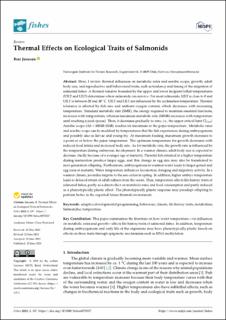| dc.description.abstract | Here, I review thermal influences on metabolic rates and aerobic scope; growth; adult body size; and reproductive and behavioural traits, such as tendency and timing of the migration of salmonid fishes. A thermal window bounded by the upper and lower incipient lethal temperatures (UILT and LILT) determines where salmonids can survive. For most salmonids, LILT is close to 0 and UILT is between 20 and 30ᵒ C. UILT and LILT are influenced by the acclimation temperature. Thermal tolerance is affected by fish size and ambient oxygen content, which decreases with increasing temperature. Standard metabolic rate (SMR), the energy required to maintain essential functions, increases with temperature, whereas maximum metabolic rate (MMR) increases with temperature until reaching a peak (pejus). Then, it decreases gradually to zero, i.e., the upper critical limit (TCrit). Aerobic scope (AS = MMR-SMR) reaches its maximum at the pejus temperature. Metabolic rates and aerobic scope can be modified by temperatures that the fish experiences during embryogenesis and possibly also as larvae and young fry. At maximum feeding, maximum growth increases to a point at or below the pejus temperature. The optimum temperature for growth decreases with reduced food intake and increased body size. As for metabolic rate, the growth rate is influenced by the temperature during embryonic development. In a warmer climate, adult body size is expected to decrease chiefly because of a younger age at maturity. Parental fish retained at a higher temperature during maturation produce larger eggs, and this change in egg size may also be transferred to next-generation offspring. Furthermore, embryogenesis in warmer water leads to larger gonad and egg sizes at maturity. Water temperature influences locomotion, foraging and migratory activity. In a warmer climate, juveniles migrate to the sea earlier in spring. In addition, higher embryo temperature leads to delayed return of adult salmon from the ocean. Thus, temperature affects life history traits of salmonid fishes, partly as a direct effect on metabolic rates and food consumption and partly induced as a phenotypically plastic effect. The phenotypically plastic response may preadapt offspring to perform better in the expected future thermal environment. adaptive developmental programming; behaviour; climate; life history traits; metabolism; Salmonidae; temperature | en_US |

